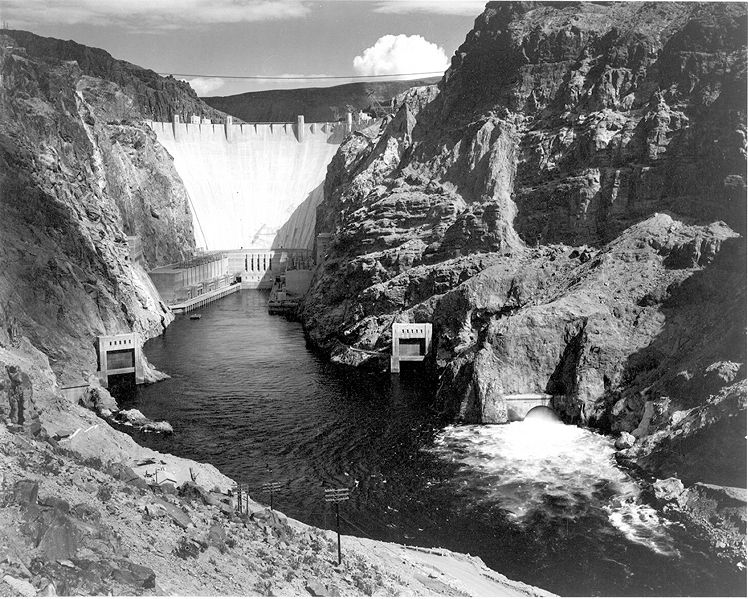The construction of the Hoover Dam (once called Boulder Dam) began in 1930 and was completed in 1936—two years ahead of schedule and well under budget. Apart from the latter facts constituting an engineering miracle in their own right, the Hoover Dam is considered one of the Top 10 Construction Achievements of the 20th Century. It used enough concrete to build a road from New York to San Francisco and it still attracts over 7 million visitors a year. Now a National Historic Landmark, “Hoover Dam is the highest concrete dam in the Western Hemisphere, standing at more than 725 feet above the Colorado River. With 17 generators producing 4 billion kilowatts of electricity a year, it also is one of the country’s largest hydroelectric power facilities. Operation and maintenance of the facility are solely supported by revenue from power sales” (more here).
The Hoover Dam was built in order to prevent flooding of the Colorado River, to provide water for agriculture in California and Arizona, and to generate massive amounts of hydroelectric energy. A major secondary benefit was the creation of Lake Mead which is 110 miles long and took six years to fill: “This boating, sailing, fishing and house-boating paradise attracts over 10 million visitors a year. Lake Mead covers 550 miles of majestic shoreline and 247 square miles of area which is twice the size of Rhode Island. Its capacity of 1 1/4 trillion cubic feet of water would cover the entire state of Pennsylvania one foot deep” (more here).
The bad news is that the creation of the dam destroyed the estuarine ecosystem of the Colorado River delta and imperiled many species of plants and animals which had adapted to the flooding of the river. Furthermore, the original two lane road remains the only access over the river, has dangerous hairpin bends, and suffers from periodic rockslides and massive congestion; and, in our post 9/11 times, the easy access to the Hoover Dam presents a serious security risk. “To provide much more highway capacity, and better safety, the new Hoover Dam Bypass is scheduled to be completed in 2010 and it will divert the U.S. 93 traffic 1,500 ft (460 m) downstream from the dam. The bypass will include a composite steel and concrete arch bridge, tentatively named the Mike O’Callaghan-Pat Tillman Memorial Bridge. Once the bypass is completed, through traffic will no longer be allowed across Hoover Dam…Because of the (9/11) attack, the Hoover Dam Bypass project was expedited. Traffic across Hoover Dam is presently restricted. Some types of vehicles are inspected prior to crossing the dam while semi-trailer trucks, buses carrying luggage, and enclosed-box trucks over 40 feet (12 m) long are not allowed on the dam at all. That traffic is diverted south to a Colorado River bridge at Laughlin, Nevada” (more here).
The Hoover Dam Bypass is a twin-rib concrete arch slated for completion in late 2010. At a cost of $240 million, the 2,000 foot bridge is part of a larger project, namely, a 3.5-mile corridor that begins in Clark County, Nevada, crosses the Colorado River about 1,500 feet downstream of the Hoover Dam, and ends in Mohave County, Arizona, providing a major link between Phoenix and Las Vegas. The bridge project will entail the removal and embankment of over three and a half million cubic yards of earth, the bridge itself will be made from two hundred and forty three million tons of concrete, and sixteen million pounds of steel will have been used to reinforce the concrete.
Design work for the Hoover Bypass Project began in August 2001, and over twelve hundred people have been involved in its construction. “A Project Management Team (PMT) was developed to oversee the design and construction of the project. The PMT has representation from each of the major project stakeholders including the Federal Highway Administration (FHWA), the States of Arizona and Nevada, the Bureau of Reclamation (BOR), the Western Area Power Administration (WAPA) and the National Park Service (NPS). Central Federal Lands Highway Division (CFLHD) will act in the lead management role for all elements of project procurement, design and construction. CFLHD awarded a contract to HDR Engineering, Inc. to provide design and construction support services for the Hoover Bypass Project. An integrated team of professionals from HDR Engineering, T.Y. Lin International, Sverdrup Civil, Inc. and several supporting subconsultants make up the consultant team, collectively known as the Hoover Support Team” (more here). I’ll bet you anything that a lot of those folks had a background in Geography…








